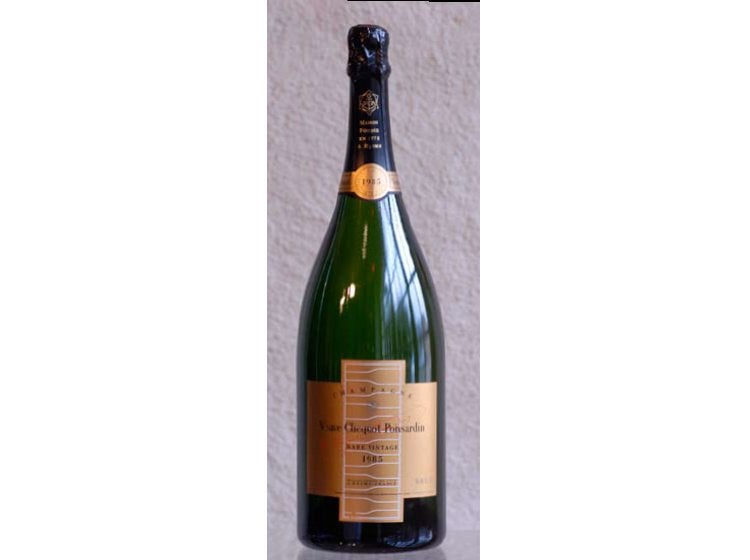
Perhaps two or three times in a lifetime of wine experience, one has the luck and privilege to attend a truly mindstretching tasting and in the most congenial company. This “Vertical Limit Tasting” of 12 great vintages of the Widow, at Le Manoir de Verzy on January 16, is certain to be one of these.
Aptly, it was organized by one of the great wine men of Champagne, Jacques Péters, chef de caves at Veuve Clicquot, now entering his 30th and final year with this eminent house before he retires at the end of 2008. These great vintages were created between 1955 and 1978 by Jacques’ three predecessors, then by Jacques and his team since 1979. Cécile Bonnefond, the current CEO of Veuve Clicquot, summarizes their approach perfectly: “Behind the bubbles and the amorous glamor, it’s the wine that counts.” That’s always been the trump card of Clicquot’s team: wine people first; technicians, however competent, second.
The tasting
The wines were tasted from 12 magnums (with a backup of a further 12 in case of problems). With the exception of the 1982, all were shown without dosage as Ultra Brut cuvées and were disgorged à la volée (i.e. with the sediment unfrozen) at the tasting. Each wine is marked out of a maximum of 20 points and are the personal rating of this one English taster in the company of true, but engagingly modest experts from France, Italy, Belgium, and Germany
1990 Bright clear gold, with green highlights, signalling freshness and youthfulness. Gentle regular bubbles. The warmth of the year shows in initially ripe aromas but, with air, mineral scents come through. The palate sans dosage gives a fascinating glimpse of the natural wine without makeup – right down to the chalk and minerals deep in the earth. Amazingly young tasting, potentially very great but still needing more time. Retaste in 2010. 17.5 for now
1989 Rosé Translucent, delicate “salmon trout” hue; elegant mousse, tiny bubbles; fine, unadulterated Pinot scents of little red fruits, obvious richness, and hints of surmaturité. Then the undosed mouthfeel springs a delightful surprise: in its core of acidity, Chardonnay, the supportive player, contributes a cleansing vitality to the opulence of the pure pinote expression: there’s no trace of harsh tannin. A mini masterpiece and ideal gastronomic wine. À point. 18.5
1988 Superb lustrous, green gold with shimmering reflections; terrific, ample nose of restrained richness, aromas of grilled bread and brioche ceding to walnuts, but with hints of the mouthwatering acidity to come. A wondrous palate, full, with an almost perfect maturity of flavors leavened by a masterly end-note of austerity. A wine for the finest seafish, especially turbot. Unquestionably great already, this is a nearperfect vintage. 19
1985 Vivid, evolved, with the almost burnished gold typical of this intense year. Bubbles rise slowly in the glass; aromas at first show unusual notes of menthol and bergamot (tea), but with a good twirl of the glass, rich Pinot scents soar up. Very round, gras, with a big presence in the mouth. Yet the foursquare flavors lack that nth degree of finesse found in the truly great. Ready. 16.5
1982 The only Champagne in the series with dosage. Interestingly, it was dosed relatively early in its life (end of 1988) which some observers would argue has preserved its keeping qualities longer, rather than inflicting the shock of dosage at a later, more fragile stage in its life. What a wine! Brighter, more elegant color than the ’85; gorgeous, sensuous aromas of coffee and buttered toast, as if served in a flower-filled room. Glorious balance of maturity and freshness. Another gastronomic wine. 19
1979 Rosé A vivid, deep Rosé with brick hints; Burgundian nose of sous bois and mushrooms. Really a wine in the classic, uncompromising, old Clicquot style of vinous Rosé; invigorating acidity still freshens the deep flavors, but there’s also a touch of quite harsh tannin, which brings the mark down. 16.5
1975 Medium-gold, monotone color, clear but hardly shimmering. Odd metallic aromas: why? The palate is still without serious flaws, but the taste of preserved rather than fresh fruits suggests that both these magnums are a little past their best; museum pieces. In this (maybe minority) view, the ’75 is relatively disappointing, at least today. Drink up. 15
1969 Rosé Both magnums were seriously corked on the nose. Disappointing, as this was obviously a wine of real substance. NS
1962 Exquisite, subtle color of Welsh gold. A ravishing nose, with every scent one could wish for: butter, toast, torrefaction, gingerbread, yet supremely fresh, floral, and delicate. Seamless confirmation of the nose in a mouthfeel that caresses yet energizes the palate. Supremely stylish. Perfection. 19.5
1961 Still strongly vivid green gold. Punchy acidity on the nose suggests a burlier wine than the ’62. Real concentration, and multilayered, on a monumental structure, with a lot of life left. Great length and latent complexities 18.5
1959 An extraordinary wine in every sense. Vinified in oak, so not a hint of vitiating oxidation thanks to the inoculating effect of contact as an infant wine with air. A dramatic color of burnished gold. Exotic scents of cream and honey, Sauternes-like. Luxuriant, opulent mouthfeel, a big presence shaped by its 13° natural alcohol from that sun-drenched summer. A wine for foie gras. 18.5
1955 Awesome vital green-gold color, miraculous for a 50-year-old wine. Still rock solid and sustained at every level. Rapierlike definition on the palate and many, many complex flavors that defy description. Just pipped at post by the superlative ’62. 19
Writer: Michael Edwards






